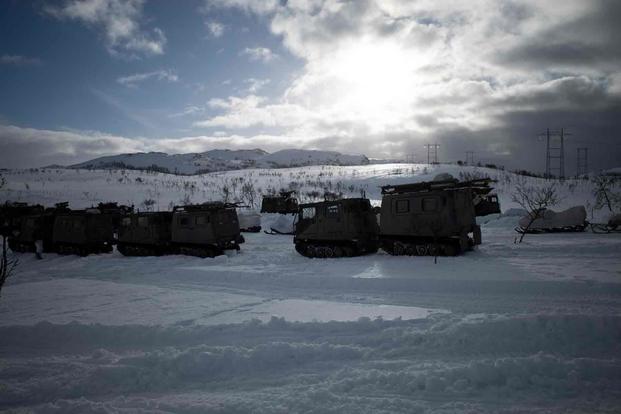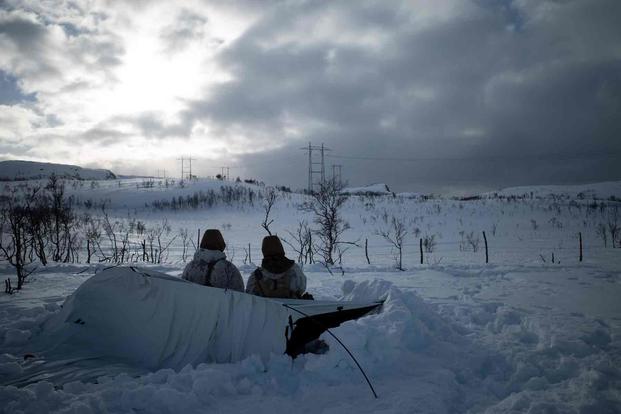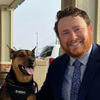ALTA, Norway -- A platoon commander barked at his Marines to get on the M240 machine gun and scan their sectors. The sun poked through sparse clouds and bounced off compact snow as they squinted across a sprawling Arctic landscape. Parts of their weapons were wrapped with white athletic tape to ward off enemy eyes and to protect their skin from contact freeze.
Nestled between two snow-laden ridges was 1st Battalion, 2nd Marines' tactical assembly area, a position that units take as they make final preparations for an operation. It was bisected by a column of snowmobiles and Norwegian Bandvagn tracked vehicles. The infantry Marines there, along with their Norwegian counterparts, were getting ready to take a defensive posture miles away in the High North.
It was a training exercise, but the risks were real. The Marines who had been working up to this deployment since November had undergone extensive cold-weather training, thanks in part to their NATO allies. Cold plunges and ski patrols were all part of the official train-up to Nordic Response 2024, a multinational exercise meant to flex military power toward Russia, especially in light of its full-scale invasion into Ukraine two years ago.
Read Next: They Stood Sentry over America's Nuclear Missile Arsenal. Many Worry It Gave Them Cancer.
It was here -- roughly 150 miles from the Russian border, as the crow flies -- that the Marine spirit was on display. In addition to their official cold-weather training, Marines in this infantry battalion were adapting and improvising to combat a formidable enemy: the Arctic environment.
"In this environment, those friction points, a lot of them ... deal with just the environment's effect on the human body," Lt. Col. Ted Driscoll, the battalion commander, told Military.com. "And I'd say the next thing is just the mobility of moving over the terrain. ... One of the things that you learn is operations out here take a lot longer."
Boots sink into the snow, costing more energy and operation time as Marines trudge to their positions, which is why they use snowshoes and skis. Vehicles go slower on the icy roads and can have a hard time starting in sub-zero temperatures. A map, too, does not tell the Marines how deep the snow is or where it lies on the route.
They are not alone out here. Part of the solution to those problems lies in the relationship between Marines and their NATO partners. For example, one of the Marine rifle companies was integrated with a Norwegian unit, embarking together to prepare for their defensive portion of the exercise. The Norwegians, who know this land, are an asset to the Marines on missions like these, Driscoll said.
But the human cost of this environment requires constant assessment. On top of hampering tactical plans, the individual Marine is battling the environment every moment they're here.
"Discipline is a big thing out here," Lance Cpl. Neal Stewart, 21, told Military.com on Thursday. The snow reflects off of shiny surfaces, he said, which could reveal a position to the enemy. The quiet of the Arctic nights -- when the wind isn't blustering -- amplifies the sound of every movement.
Headlamps are a big no-go because "anyone can see from all around here," Stewart said. He recalled that, during a live-fire event, his M240 kept sinking into the snow, hindering accuracy. That is, until Marines placed it on snowshoes and jammed the tripod into a pair of Crocs (yes, the footwear) to prevent it from slipping deeper into the tundra.
"I was surprised when we were telling the higher-ups. It sounds stupid," he said. "[But] our battalion gunner, he saw it and was like, 'I liked that.'"
Along with the white athletic tape, Marines took strips of white laundry bags and cut them to attach to their uniforms as camouflage, breaking up the typical coyote brown color of their body armor plate carriers. They're also not shaving, as razors in cold weather can irritate the skin to detrimental effect. Stewart said cold Marines might pop up to do some squats or run a few laps to stay warm. Even urinating and defecating come with risk, as any opening in the uniform means lost body heat, something that Marines are wary of as they face the cold.

Second Lt. Timothy Covert, a logistics officer assigned to the battalion, said that something as essential as water could be hard to come by if troops are unprepared to utilize the environment.
"Something that we discovered about the Arctic is through the proper techniques of being able to process the snow that we have here, we're able to create our own water supply just from the environment we have around us," he said, which includes melting down snow, killing the bacteria, and making sure it's not taken from where Marines relieve themselves.
"That's an entire class of logistics supply that the battalion can provide for itself without needing any external support," he said.
The Marine Corps is participating in, and in part leading, Nordic Response 2024, which is part of the largest NATO exercise in decades. They are working with new members of the coalition as well, including Finland and Sweden, which officially joined NATO on Thursday. The Marines are not new to this environment: Some were here in 2022 for the exercise, formerly known as Cold Response.
Throughout the exercise, Military.com will be in the High North, above the Arctic Circle, reporting on the Marine Corps' efforts and participation in the operation.
While the physical environment is not new, the geopolitical one is. Those changes center around Russia's invasion of Ukraine and have had deep effects on NATO's concern for deterrence against the Kremlin.
"Just the name change of the exercise from Cold Response to Nordic Response I think reflects a major change," Becca Wasser, a senior fellow for the defense program at the Center for a New American Security, told Military.com on Tuesday.
"Russia's invasion of Ukraine really paved the way for them to rethink their stance and become NATO members and improve their existing coordination and alignment with NATO allies, and NATO as a headquarters organization," she said.
On the ground, as columns of Norwegian Bandvagn came in and out of the assembly area, Marines continued to monitor their posts. Some strapped down supplies to snowmobiles while others rested in tents, no doubt after coming off their own shifts.
Stewart, the young Marine who helped improvise the Croc tripod, said that he keeps awake and warm by reminiscing with his compatriots about home while they're on the gun. He said he is going to have a big cookout with his family when he's on leave.
Driscoll, the battalion commander, had his own tactical ecosystem in Norway and contemplated what it would be like to fight an adversary in this environment. What equipment do they have? Are they more or less experienced than us? Do they have more time in the cold weather?
"I think top of mind for me is understanding that the weather is going to impact both sides. It's not only impacting friendly forces," he said.
Related: Trigger Finger Mittens on Marine Corps Cold Weather 'Snivel Gear' Wish List













